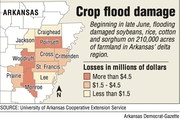Flooding that began in late June will lead to more than $35 million in lost crop value for farmers in 10 Arkansas counties, though the full extent won't be known until after harvest, according to a University of Arkansas Cooperative Extension Service study.
Soybeans were the most affected crop, with $28.4 million in losses. Rice farmers suffered $5.6 million in losses, followed by corn and sorghum, with $1.5 million in losses; and winter wheat, with $100,000 in losses, according to the study released Friday.
"It's going to put [farmers] behind the eight ball. It'll take them a couple years to recover from it," said Van Banks, cooperative extension agent staff chairman for Monroe County. "Some [crops] survived; some didn't. There wasn't much rhyme or reason as to what survived and what didn't."
Monroe, Poinsett and Woodruff counties were most affected, with $4.5 million in losses. Crittenden, Cross, Prairie and St. Francis counties each had losses between $1.5 million and $4.5 million. Craighead, Jackson and Lee counties were least affected. Each had losses of less than $1.5 million.
Flooding wasn't as widespread as in 2011, when floods cost farmers $335 million in damage.
And flooding won't have much of an effect on the state's total agricultural output. Arkansas farmers produced $1.84 billion worth of soybeans in 2013, according to the U.S. Department of Agriculture's National Agriculture Statistics Service. Soybean losses this year accounted for about 1.5 percent of that total.
But Branon Thiesse, cooperative extension agent staff chairman for Craighead County, said the flooding decimated farms. He said his was one of the least-affected counties that suffered losses from flooding.
"It wasn't anywhere near like it was down South," he said. He added that the St. Francis River overflowed from its riverbed into surrounding fields before it receded. "It was just in fields that bordered the river."
However, the flooding, which came unusually late in the year, forced affected farmers to make tough decisions about replanting and delayed planting, Thiesse said.
Yields decline rapidly for soybeans planted after June 15. And with low commodity prices, farmers will have difficulty recouping their investment.
"It just got to the point -- there was just too much ground to cover and not enough time," Banks said. "Some of these guys who did replant, they'll be very lucky to make half a crop."
More than 20 Arkansas counties were designated as disaster areas by U.S. Agriculture Secretary Tom Vilsack in late July because of the flooding.
The designation allows affected farmers to receive low-interest loans from the USDA.
"It's going to help a little bit, but you know ... it's not going to be enough to completely bail them out," Banks said. "It's a long road ahead."
Business on 09/03/2014
